Calisthenics Exercises List: From A Complete Beginner To Master
Hey there, fitness enthusiasts and aspiring superheroes! Are you ready to explore the extensive calisthenics exercises list?
If you’ve ever dreamed of defying gravity or simply impressing your friends with your incredible strength, then you’re in for a treat. This list will take you on a journey from an aspiring beginner to a full-blown calisthenics master.
You will learn the moves that are covering all skill levels, from a total beginner through intermediate up to an advanced calisthenics elite. The calisthenics exercises list is sorted from the easiest to the hardest for each muscle group. So, let’s jump right in.
Calisthenics Exercises List: 4 Exercise Groups
The calisthenics exercises list can be sorted into four groups that are useful for creating your own workouts. The groups are:
- Push Exercises
- Pull Exercises
- Leg Exercises
- Core Exercises
With push exercises, you will be pushing your body weight against gravity. With those kinds of exercises, you will be either working your shoulder muscles, or chest, and triceps.
Pull exercises will work your upper back and biceps.
When you are working your legs there are 4 different muscle groups you will be targeting:
- Quads
- Glutes
- Hamstrings
- Calves
When working on your core, you are working on your lower back, or your abs and hip flexors.
Push
Let’s start the calisthenics exercises list with push exercises. You will push up and lower yourself down with your arms at various angles. With push exercises, you will target the following muscle groups:
- Chest
- Triceps
- Shoulders
Pull
With the pull exercise type, you will be usually pulling your body up. Pull-ups and chin-ups are probably the first ones that come to your mind. Those exercises will be used for working on your:
- Upper back
- Biceps
Legs
Let’s continue our calisthenics exercises list with leg exercises. Here are the muscle groups in focus:
- Quads
- Glutes
- Hamstrings
- Calves
Core
When you are working on your core, you can be working on the front of your core, or the back of your core. The front of your core is your abs and your hip flexors. The back of your core is your lower back muscles.
So, with core exercises, you will be working on:
- Abs
- Hip flexors
- Lower back
Now let’s dive into the calisthenics exercises list for each muscle group.
Chest and triceps
Let’s start with one of the easiest exercises almost anyone can do – knee push up. This is a beginner-level skill and a great preparation for building your upper body strength.
But if by any chance this exercise is too hard for you, you can experiment with even easier exercises from a plank progression. Those exercises are more on the absolute beginner/injury recovery level.
So, if this is where you are starting from, it’s absolutely fine. There is something to choose from for every level of experience and fitness capability.
1. Knee Push-Up
- Place your hands on the ground while kneeling down. Try to keep your body from your knees to your head in a straight line.
- Lower your upper body to the floor aiming to touch the ground with your chest.
- When your chest touches the ground push away from the floor to get back to the starting position.
2. Incline Push-Up
The harder version of a pushing exercise is an incline push-up. You will do it like regular push-ups but with your hands on the box or any other sturdy elevated surface that you can find (couch for example).
- Place your palms on the box and your feet on the ground (your weight should be on your toes and your feet balls). Keep your body from your feet to your head in a straight line.
- Lower your body down by bending your elbows.
- When your chest touches the box push away from it to return to where you started from.
3. Push-Up
Standard push-ups will add more difficulty to your push workouts. They will be harder to do than incline push-ups. The movement will be the same as in incline push-ups. Only, this time your legs and your arms are on the same level.
4. Decline Push-Up

When you place your legs on the box with your hands on the floor, you are adding another level of difficulty to your push-ups. The movement will be the same as in push-ups. Only the position will be different.
5. Clapping Push-Up

Calisthenics is great for having fun and working out at the same time. When you gain basic strength it’s time to explore the fun side.
After standard push-ups, when you can explode away from the ground and remain in the air for a while, it’s time to try clapping push-ups.
There are so many variants of clapping push-ups you can try. The longer you can stay in the air the more variants you can explore. You can clap with your hands in front of you, over your head, or behind your back. You can even make clap combinations.
6. Archer Push Up

Archer push-ups are harder than other push-ups you have been doing using both of your arms equally. It will move you a bit closer to one arm push-up. You will push using one arm dominantly and the other placed wide to the side.
7. One Arm Push Up

Did you ask for the most advanced push-up exercise? Well, one-arm push-ups might be just that. It’s a very hard exercise. You will need both strength and balance to pull it off. Luckily there is an entire progression that will help you master this difficult exercise if you keep persistent.
Shoulders
Another muscle group you may be working in a pushing fashion is your deltoids or your shoulder muscles. You can start with easy exercises in the beginning and work yourself up to the most advanced when your strength and balance improve.
An easier pike push-up progression will help you start and if you feel up to the challenge you may even tackle handstand push-ups.
8. Downward dog
We are starting this list of shoulder exercises with a downward dog. This exercise actually comes from the world of yoga. At first, it may look pretty easy. But, when you scratch a bit under the surface, you will find this might be a pretty challenging skill to master. If you concentrate on lowering your heels to the ground, you may find out there is some flexibility you are missing. I know I did.
9. Pike push-up
To do a pike push-up, start in a downward dog position. Bend your arms and touch the ground with your head and return back to the starting position. Sounds simple, but it’s not. If you want to do this move perfectly there is much more than meets the eye in a first glance.
10. Elevated pike hold
Elevated pike hold will bring you one step closer to a wall handstand. When you put your legs on the box and do a pike hold with your hands on the floor you are getting more vertical than in a pike push-up. You will hold this position as long as you can.
11. Wall handstand
You walk up the wall until you are facing the wall with your head. This will be scarier than the other way around (kicking up to a wall handstand and facing away from the wall).
But if you do it this way, you will slowly reduce your fear of falling over which will help you later on. When you will want to move away from the wall and do the freestanding handstand, this will prove its worth to you.
12. Wall handstand push up
When you can do a wall handstand, you can try lowering down. When you are able to bend your arms, touch the ground with your head and lift back up, you are doing the full wall handstand push-ups.
13. Handstand
Handstand, or freestanding handstand is more of a balancing than a strength skill. The main problem with getting into a handstand is overcoming the fear of falling over on your back. This is something you work on through time and terror. I’m still struggling with this.
14. Handstand push up
Handstand push up is where you finally combine strength and balance in one impressive skill. This is one of the most advanced calisthenics moves. There is a complete progression dedicated to mastering this exercise.
Upper back and biceps
Now are getting into a world of pulling strength. The first exercises that probably instantly pop into my mind are pull-ups and chin-ups.
But let’s start with easier exercises and move on to harder and harder below.
15. Low Bar Hang
Low bar hang is as easy as it can get. You just grab a low bar and hang as long as you can. Forget about how simple it sounds, this is a great exercise. It’s also the one that has a special place in my heart.
If I didn’t know about it I will never be able to do pull-ups. I started with low bar hangs and inverted rows before I was even able to hang from a high pull-up bar.
16. Low Bar Chin Up
One of the easiest pulling exercises is the low bar chin-up. You have to find some low object you can grab and hang from. If nothing else, you can hold onto your kitchen table edge. It will be much harder than holding onto a bar, but it will also work wonders on your grip strength.
17. Low Bar Pull Up
People invented all kinds of names for a low-bar pull-up. It’s also known as the Australian pull-up or inverted row. The name is not that important. But this exercise is great for improving your strength in the early days when you can only dream about doing your first real pull-up.
18. Dead Hang
Dead hang is another exercise that at first glance looks stupidly simple. This is another one that keeps a special place in my heart.
When I was finally able to just hang from a high pull-up bar, I knew I will soon be able to do my first pull-up. Somehow this exercise proved to me pull-ups are achievable.
19. Chin Up
Chin-ups were easier for me than pull-ups. When I was able to build initial basic strength my arms were strong enough to pull me up toward the bar. My back muscles and especially my rear delts were lagging in development.
20. Pull Up
After I mastered chin-ups, pull-ups were just a few reps away for me. When you can finally do your first few pull-ups it will be a great achievement in your fitness journey.
21. Chest To Bar Pull Up
When you master standard pull-ups you can slowly get your pull-ups higher and higher. In regular pull-ups, you will get your chin over the bar and that’s it. The next step further is mastering chest-to-bar pull-ups.
22. High Pull Up
After the chest-to-bar pull-up, you would want to fly higher and higher over the bar. The goal would be high pull-ups where you are pulling yourself up to your belly button.
23. Muscle Up
The only thing left after you master high pull-ups is transforming it into a muscle up. When you do a high pull up you lean over the bar and do a straight bar dip. And that’s muscle up. Sounds easy? Well, only until you actually try to do it.
Legs
When you are working on your legs there are four main muscle groups you can focus on. It’s your quads, glutes, hamstrings, and calves. When you are starting with your leg workouts you can follow a beginner-friendly squat progression.
24. Calf raises
Calf raises are beginner-friendly calves exercise. You just lift your heels off the ground and that’s it. If you feel like falling you can hold onto something. But you can also do it without holding if you can balance.
25. Single-leg calf raises
Single-leg calf raises are harder to do than calf raises. If single-leg calf raises are too easy for you, you can always add some external weight to make it harder. I prefer using a weighted vest.
26. Glute Bridge
Glute bridges are great for beginners looking for an easy glute exercise. As the name suggests, it’s an exercise mainly working your gluteus maximus. You are simply laying on your back and lifting your butt off the ground. That’s it – glute bridge mystery solved.
27. Wall sit
After working on your glutes it’s time to make your quads burning. Wall sit will do just that. Make yourself comfortable and sit on an imaginary chair. Lean your back against the wall and keep your legs bent at 90 degrees. Wait for a while and feel your legs starting to shake. Now you can start feeling how effective this exercise is.
28. Squat
We can’t avoid the all-time classic – a regular squat. It’s another exercise that will mostly target your quads. Everyone knows about squats and uses them in leg workouts.
29. Lunge
When you master squats and want more challenge, there is a whole new world you just uncovered. A pistol squat progression will keep you busy and make your legs burn like never before. The easiest exercise from this progression is the lunge. The great thing about lunges is they will work your quads, glutes, and hamstrings at the same time. You spread your legs one in front of the other and lower your butt until you touch the ground with the knee of your back leg.
30. Bulgarian squats
Bulgarian squats are similar to lunges but with added difficulty. You place your back leg on a bench and do the same movement as with lunges. Try it and feel the burn in your thighs and glutes.
31. Levitation squats
If I would single out a leg exercise this would definitely be levitation squats. I got this one from an Athlean Xero workout program by Jeff Cavalier. It burns my quads, hamstrings, and glutes at the same time. After a deload I can never start with this exercise right away. I have to go through a few workouts working on lunges and Bulgarian squats. Only after a few prep weeks, I can do levitation squats again. Thanks, Jeff for killing my legs.
32. Pistol squats

Of course, this list will make no sense without mentioning the calisthenics all-time favorite leg exercise – the legendary pistol squat. When I thought I finally mastered pistol squats I checked my form and discovered a devastating truth – I was only doing half pistol squats. I still miss the flexibility and strength to pull this move off. Maybe you can?
Abs & hip flexors
There are loads of exercises targeting your abs and hip flexors. There are fewer options targeting your obliques. But let’s start with the easiest ones and cover them all here. The easiest exercises will start on the ground using a laying leg raise progression and move onto a pull-up bar with a toes-to-bar progression.
But you can also experiment with dragon flags and front levers. Don’t worry, I will put all the key exercises here.
33. Laying Knee Raise
Even though laying knee raise is the easiest abs/hip flexor exercise it got me working on it for a few months when I started.
I was following The Movement Athlete training program and the prerequisite for moving onto leg raises was 3 sets of 30 reps knee raises. It was pretty hard to achieve for me.
The exercise is pretty simple. You lay on your back and lift your knees toward your chest and lower your legs back down. Pretty easy, don’t you think?
Well maybe if you don’t need to do 30 of those and then repeat the torture three times. I believe I will have a hard time doing this again.
34. Laying Leg Raise
Laying leg raise is another abs and hip flexor killer. I still revert to this exercise when I have problems with my shoulders and can’t hang from a bar.
Doing 3×12 will make me feel my abs for a day or two after the workout. So, I know I did some good work.
The exercise is simple. You lay on your back and lift your straight legs off the ground. Then you lower your legs back and repeat.
35. Knee Windshield Wipers
Let’s work your obliques, shall we? Laying knee windshield wipers will help you work your obliques when you are starting out. It’s a relatively easy exercise.
Lift your knees up and lower them to your left and then to your right side.
36. Hollow Hold
Your core work would not be complete without the hollow hold. This exercise will be very important in every other pushing and pulling exercise that you do.
The hollow hold is how your body should be positioned when you hang from a bar. It is also how your body should be positioned when you do push-ups (but with your arms placed on the floor). A hollow hold is also the position of your body when you do handstands (but this time upside down).
Think of a hollow hold as a cornerstone position of your body in most of the calisthenics skills. So, it’s very important to master it early on.
37. Hanging Knee Raises
Let’s move our core work onto a pull-up bar. The easiest exercise is a hanging knee raise. You are hanging from a bar and lifting your knees toward your chest.
38. Hanging Knee Side Raises
Here’s another exercise targeting your obliques. It’s similar to hanging knee raises. Only now, you will be raising your knees to your sides – left and right.
39. Hanging Leg Raises
Hanging leg raises are harder than hanging knee raises. When you lift your straight legs it will be more difficult than when they are bent. It’s because the lever your legs are forming when they are straight is longer than when they are bent.
40. Toes-To-Bar
Toes to bar is a hanging leg raise on steroids. You are not only lifting your legs to the point where they are parallel to the floor, but you go all the way up until you touch the bar with your legs.
This will be very hard to do. It will require both strength and hamstring flexibility.
41. Dragon Flag
Another pretty cool and pretty hard exercise is a dragon flag. You will be lifting your entire body from the ground with only your neck and shoulders on the ground.
So the entire weight of your body must be lifted against gravity. This is very hard to do.
42. Tuck Front Lever
After dragon flags there is another level of difficulty to master – that’s the front lever. The easier version is a tuck front lever where you will hold the front lever position with your knees tucked to your chest.
43. Front Lever
The front lever is one impressive and insanely difficult exercise. Only a handful of people are able to do it. Are you the one who can?
Lower back
There are only lower back exercises left to uncover. There are two progressions that cover this, the bridge and the back lever.
44. Superman lifts
One of the easier lower back exercises is the superman lifts exercise. You will be laying on your belly and lifting both your arms and legs from the ground at the same time.
45. Reverse plank
Reverse plank is an isometric hold exercise. You will sit and place your hands on the floor a bit further from your butt. When you lift your butt off the ground and your body is in a straight line from your feet to your head you will hold this position.
46. Bridge
To do bridge you have to have strong lower back muscles and your back needs to be flexible, so you can bend backward. It’s another challenging isometric hold exercise.
47. Skin The Cat
Skin the cat sounds pretty violent. Luckily this is just another exercise. It may look and be dangerous if you just went for it without any preparation. But there is a way to go for it one step at a time and save yourself from injury.
48. German Hang

Skin the cat is the prerequisite for German hang. German hang is just holding the lowest position of skin the cat.
49. Tuck Back Lever
Tuck back lever is the easiest version of back lever hold. You will be holding back lever position with your knees tucked to your chest.
50. Back Lever

The back lever is pretty hard and impressive calisthenics skill. Definitely, something worthwhile pursuing.
Calisthenics Exercises List Bonus
Now that we covered all calisthenics exercises list by specific muscle group it’s time to add some calisthenics classics as a bonus.
51. Planche
Planche is another brute strength exercise reserved for aliens only. You need superhuman strength for it, but if you think you have what it takes – be my guest.
52. L-Sit
This list would not be complete without L-sit. It’s also a core exercise and a calisthenics classic.
53. Human Flag
I don’t know who came to the idea of trying to make himself look like a flag, but here it is. This exercise will make you do just that. The calisthenics exercises list would not be complete without it.
Calisthenics Exercises List Summary
So here it is. We went through a comprehensive calisthenics exercises list. From the easy ones suited for complete beginners to the most advanced. The most advanced will perhaps require some DNA alterations before you can pull them off.
But joking aside, all of those skills come with a step by step progressions. Progressions will help you work your way up slowly to the most impressive skills you thought are impossible to do.
If you persist and keep patient, most of those exercises will be attainable. So, keep on pushing. Mastery is just another step away.






